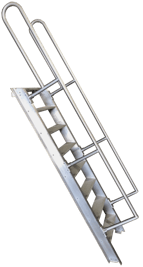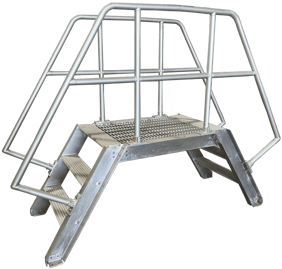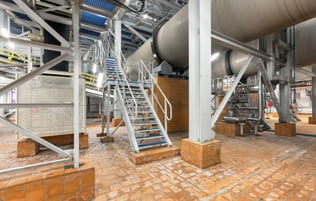
When it comes to being able to easily maneuver in the tight spaces of service and mechanical areas of facilities, or to cross over mechanical equipment, pipes, and other objects that would be difficult or impossible to walk through or around, ships ladders are ideal products for those functions. Part stair and part ladder, ships ladders, sometimes called ships stairs or crossover stairs, can also be used for easier access to rooftops.
Ship ladders generally are angled at 60°-70°compared to the standard 45° of a conventional ladder. The vertical rise of a conventional ladder between the treads (rungs or steps) is about 9”. In contrast, the width of a ships ladder is approximately 24”, and the depth of its tread is usually 6”. What’s more ship ladders are always sold with handrails.
Making the Right Choice
When deciding which ships ladder is best for your environment, it is necessary to have the precise dimensions of your space requirements so you can get this vital piece of equipment into service as quickly as possible.
 Besides knowing the size requirements of your upcoming purchase, you should also be aware of the clear guidance that the U.S. Occupational Safety and Health Administration (OSHA) provides related to the use of ships ladders.
Besides knowing the size requirements of your upcoming purchase, you should also be aware of the clear guidance that the U.S. Occupational Safety and Health Administration (OSHA) provides related to the use of ships ladders.
In 29 CFR Section 1910.25, the regulations clearly state that ships stairs should be used only in locations where it is not possible to use standard stairs. The details are spelled out here.
If you have questions about the regulations, the Thompson Fabricating team can help you determine how to best comply with the letter and spirit of those requirements while meeting your specific needs.
The Purchasing Process : A Checklist
.jpeg?width=263&height=175&name=Thompson%20Fabricating%20--%20Blog%20Post%20Checklist%20Image%20(Jan.%202024).jpeg) After you have determined the dimensional accuracy of the space in which your ships ladders will be used, it is best to consult with an engineer or customer service representative (CSR) at a ships ladder manufacturer to request options for ladders that meet your requirements.
After you have determined the dimensional accuracy of the space in which your ships ladders will be used, it is best to consult with an engineer or customer service representative (CSR) at a ships ladder manufacturer to request options for ladders that meet your requirements.
At some companies, including ours, engineers and CSRs are the same person, or they have extensive knowledge of engineering principles so they can interface effectively with engineers on your behalf.
To obtain a ships ladder that is ideal for your environment, you will need to determine these features by yourself or with assistance from an expert:
- Budget (How much do you want to invest? A manufacturer can then “work backward” from that number instead of providing options that do not match financial limits.)
- Material (e.g., aluminum, steel)
- Diameter of tube used to make the rail (e.g., 1.5” aluminum)
- Tread (step) width and material (e.g., 24” wide diamond)
- Depth of Tread (e.g., 5”)
- Angle (e.g., 65°-70°)
- Rise (distance between treads/steps, e.g., 9”)
- Paint color (e.g., standard gray, safety yellow)
Regarding material selection, some ships ladders are made of steel, but most, including ours, are made of aluminum. By using a non-ferrous metal to manufacture ships ladders, these climbing structures will not corrode, which makes them ideally suited for use in water treatment plants, food and beverage processing facilities, laboratories, and other environments that require frequent washing or are exposed to the elements.
Maintaining Your Ships Ladders
 To keep your ships ladders in top working order, you should clean them after each use and make sure the treads are free of oil, grease, grime, and other substances that can make ladders unsafe to use and which can cause lost-time accidents.
To keep your ships ladders in top working order, you should clean them after each use and make sure the treads are free of oil, grease, grime, and other substances that can make ladders unsafe to use and which can cause lost-time accidents.
Making certain that ships ladders are always clean means using the right cleaning products to rid the ladders’ treads of foreign substances. Generally, soap and water or an industrial cleaning fluid will suffice.
Given the variety of materials that users can track onto the treads of ships ladders, it is important for cleaning fluids and the heavy cloths used to apply them, to be easily accessible to ladder users and to custodial staff.
Conclusion
 Although ships ladders appear to be simple pieces of equipment, it is essential that buyers and specifiers do a thorough job of sourcing the ideal ships ladder for a particular manufacturing, maintenance, or other kind of industrial setting.
Although ships ladders appear to be simple pieces of equipment, it is essential that buyers and specifiers do a thorough job of sourcing the ideal ships ladder for a particular manufacturing, maintenance, or other kind of industrial setting.
That is because the consequences of having an inadequate ladder can be workplace injury that can result in people becoming incapacitated in ways that could have been prevented, missing time from work, compromised productivity, and higher insurance premiums.
Fortunately for companies that need ships ladders, there are experts who are qualified to help users make the best purchasing decisions and bring safe, application-appropriate ladders into service as quickly as needed. To discuss your specific needs…